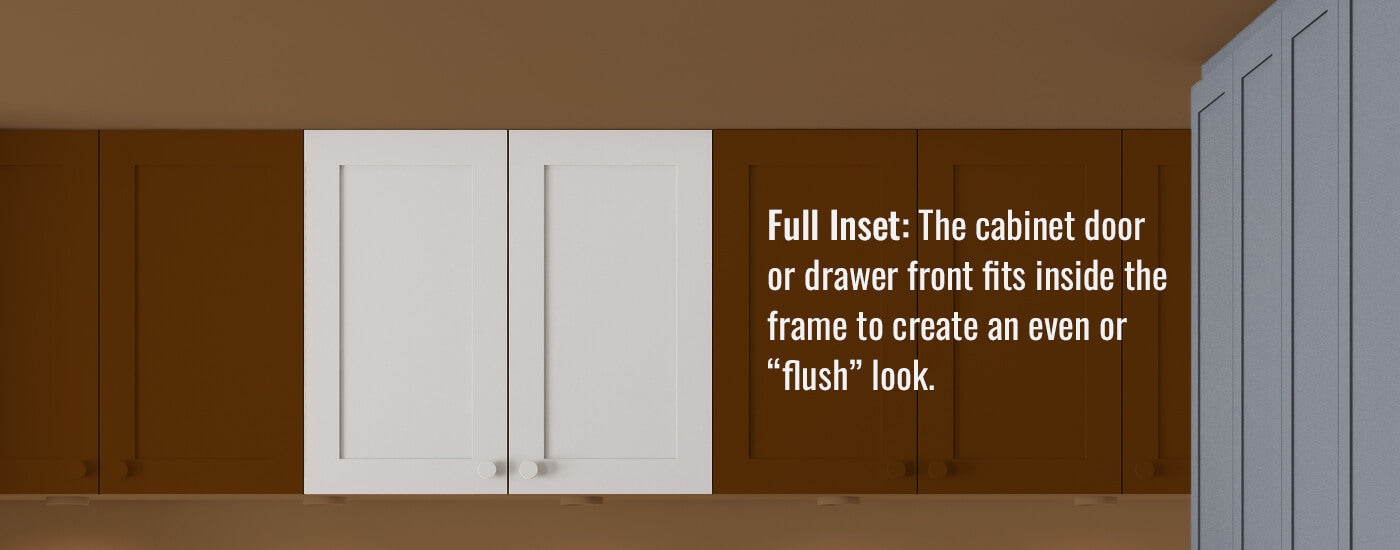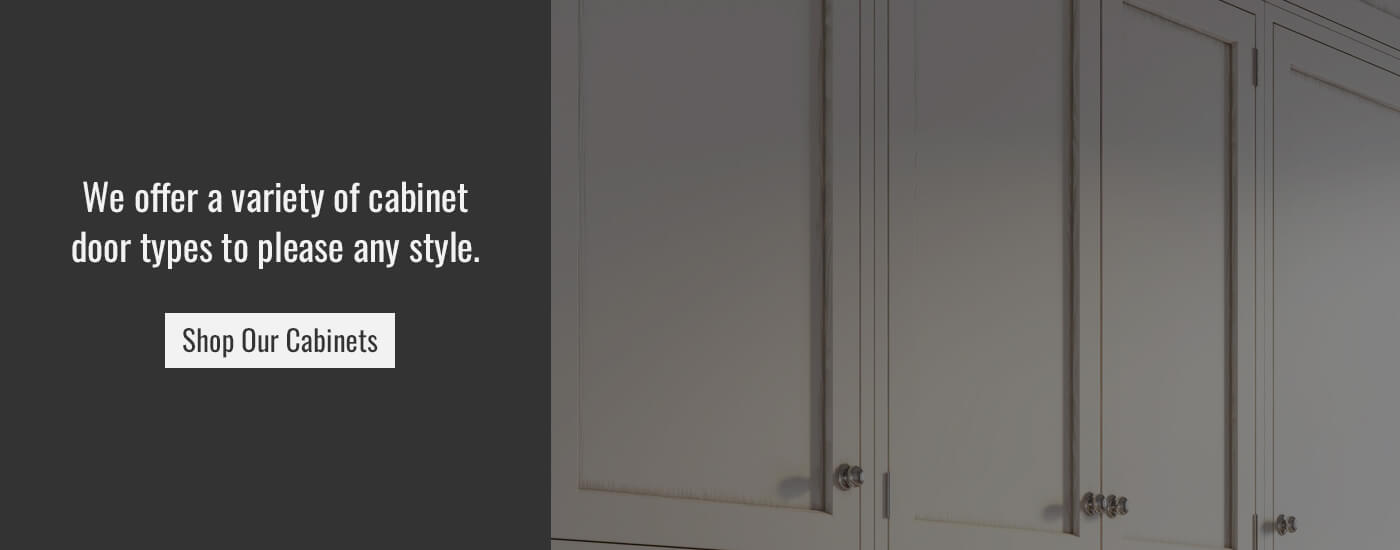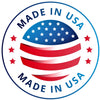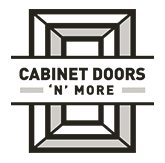
The right cabinets can transform any bathroom or kitchen into a work of art. Likewise, old kitchen or bathroom cabinets and drawers can make a space feel outdated. If your cabinets and drawers are leaving you feeling uninspired, you may want to consider replacing them. If you've never attempted such a project before, you may be unsure where to begin.
Learn How to Order
The first step is understanding popular cabinet terminology. This will help you prepare for the specialized work that lies ahead. You want to make sure you refer to each component of cabinet door construction properly to ensure a successful project. The cabinet experts at Cabinet Doors 'N' More have assembled this guide to help familiarize you with kitchen cabinet parts names. Read on to take your next step toward installing the cabinets of your dreams!

BASIC CABINET TERMINOLOGY
First, we must define "cabinet." A cabinet refers to a doored structure with or without shelves (and sometimes without doors) in which people can store items. People around the world have used cabinets throughout their lives to store various possessions. They can either be a standalone piece of furniture or a part of a larger system of cabinets installed in walls or along baseboards. You'll find that the world of cabinets is bigger than you might think, so it's important to get to know as many cabinet details as you can.
If you need to know kitchen cabinet parts or the names of cabinet pieces for bathrooms, use this guide as your dictionary to navigate all the new terms and definitions:
-
Wall cabinets:These attach to the wall above counters and other kitchen structures. With wall cabinets, you'll stand or reach up to access the items inside. They're placed either a few inches from or right against the ceiling.
-
Base cabinets:Base cabinets mount along the baseboard of your kitchen or bathroom walls. You'll have to stoop down to reach the items within. The bottoms of the doors are a few inches from the floor to give room when opening and closing them.
-
Cabinet box:You can also refer to this as the "cabinet carcass." This is the full shape of the cabinet, including the back, sides, top and bottom. It makes a box shape with space inside to store items. The front of the cabinet box is left open to allow access inside. The cabinet door rests over this opening.

-
Drawer box:Like the cabinet box, a drawer box creates the true shape and size of a drawer. It consists of two side panels as well as a front, back and bottom panel. The drawer box is left open to give you access to the contents inside. Cabinet Doors 'N' More offers 4 sided drawer boxes, unlike other distributors which sell 3-sided drawer boxes.
-
Hinges:These are the pieces of hardware that connect the cabinet door to the cabinet box. They allow the door to open and close.
-
Drawer or cabinet face:This is the visible front of a cabinet or drawer. In standard cabinets, the face showcases the front of the door and the surrounding frame, depending on the style of cabinetry. In cabinet drawers, the face is the finished front of the box that contains a handle for opening the drawer. The drawer face can also reveal the surrounding frame if desired.
-
Face frame:The face frame is the front of the cabinet's structural box. The door attaches to the face frame and rests against it when in the closed position. It consists of two vertical and horizontal sections to create a box appearance. The hinges attach to the face frame of the cabinet box.
-
Rails: These are the horizontal sections of the cabinet face frame and cabinet door.
-
Stiles: The stiles are the vertical sections of the face frame and cabinet door.
-
Frameless cabinet or drawer:In these types of cabinets and drawers, the door or front panel completely covers the face frame. There is no area of finished frame revealed or hidden behind the door, providing a larger opening than a cabinet with a revealed frame. The hinges attach to the inside left and right panels of the cabinet box.
-
Cabinet overlay:This refers to the amount of frame the cabinet door covers when in the closed position. As you'll see later in the guide, there are two types of cabinet overlays: partial and full. These reveal differing amounts of the cabinet's face frame.

-
Full inset:You can think of this as the opposite of cabinet overlay. Full inset cabinets and drawers reveal the cabinet's entire face frame. The cabinet door or drawer front fits inside the frame to create an even or "flush" look. The door or drawer front could be flush with the surrounding rails and stiles.
-
Wood species:The wood species of your cabinets refers to the type of wood used to construct their components. Each wood species will have a different appearance, weight, woodgrain and texture. Wood species include pine, birch, cherry, maple, oak and more.
-
Woodgrain:The woodgrain of your cabinetry is the swirling rings and lines of the wood itself. It provides an appearance of layers and shapes. The woodgrain appears naturally within the wood and varies from product to product. Look at different species of wood to see which has a woodgrain that appeals to you.
-
Unfinished:When you hear the word "unfinished," understand that the wood is completely raw. There is nothing covering, sealing or protecting it. You'll have to finish unfinished wood soon to persevere its longevity and enhance its appearance.
-
Paint:One way to finish your cabinets' wood is by painting it. Paint provides a solid-colored layer of protection for the unfinished wood. You can choose from various colors to match the rest of your house, complement existing hues or add a splash of contrast to spice things up.
-
Stain:Stain comes in both solid, semi-transparent and transparent varieties. Wood absorbs stain to provide long-lasting benefits, like waterproofing. Stain adds a touch of color to your wooden cabinets and drawers while allowing the wood's grain to shine through.

CABINET ACCESSORIES
As you plan your cabinet upgrades, you'll find there are many options to choose from. There seems to be a customization option for everything, from the inside to the outside of your cabinets and drawers. One reason for this cabinet terminology guide is to show you some of the options you have. That way, you can choose the perfect cabinet system for you and your family. Use the terms and definitions in this guide to reach the full potential of your home's cabinets.
Shop Cabinet Accessories
As you choose customization options for your cabinets and drawers, keep some cabinet accessories in mind. These will add personalized characteristics to your cabinets, giving them a unique look. They also provide various features you might find appealing. Here are some cabinet characteristics to consider when planning your cabinet renovations:
-
Fixed shelves: Many cabinets contain shelves to provide layers on which to store your items. In fixed-shelf cabinets, the shelves are built into the cabinet during the construction process. They're a part of the cabinet box or carcass. The shelves' current location is where they will stay. Fixed shelves are sturdy and can hold more weight than adjustable ones.
-
Adjustable shelves:In adjustable-shelf cabinets, you have the freedom to move the shelves to a location that better suits your needs. Adjustable shelves are pieces of wood that slide into grooves in the cabinet's frame. Sometimes there are small pegs sticking from the inside of the side panels on which you can rest the shelf. The grooves or pegs will occur at various heights, allowing you to choose a new slot for your shelf.
-
Toe kick: The toe kick is a recessed area beneath the door of base cabinets. This gives your feet more room as you approach your cabinets. Without a toe kick, you may find yourself banging your toes into the area below your base cabinet doors. With a toe kick, you'll have more room when you need to get up close to your cabinets.
-
Concealed hinge: A concealed hinge exists within the box. This keeps it hidden when the door is closed. When you open the cabinet door, you can see the hinge connecting the door to the cabinet box.
-
Exposed hinge: You can see exposed hinges on the outside of cabinet doors. Many people prefer the sleek design of concealed hinges, as low-quality hinges might be unsightly. However, exposed hinges can add character to cabinets, depending on the design. Beautiful exposed hinges are a popular choice for homeowners going for a more elegant or even rugged appearance.

PARTS OF A CABINET DOOR
Now that you know a bit more about popular cabinet terminology, it's time to get more specific. In this section, we'll look at cabinet doors. They're one of the most important parts of your cabinet because they're the most visible. You'll be looking at them every day. When you invite guests into your kitchen, the first thing they'll see is your cabinet doors. For this reason, you should take the time to learn more about cabinet doors so you can choose the exact types you want.
Here are some custom cabinet door terms you should know:
-
Center panel:This is the section within the rails and stiles of a cabinet door. It can be either flat or raised.
-
Edge profile:This refers to the details making up the outer edge of the cabinet door.
-
Framing bead:This is the detail of the inside edge of a cabinet door or drawer front.
-
Panel raise:The panel raise is an indentation in the cabinet door surrounding the center panel. It begins on the inside perimeter of the stiles and slopes upward into the center panel to give the door a three-dimensional look.
-
Prepped for glass:We can build cabinet doors without an inside center panel. This allows you to install a glass panel in the door to provide visibility into the cabinet.
-
Cabinet materials:Cabinet materials consist of a wide variety, such as solid wood, rigid thermofoil (RTF), medium-density fiberboard (MDF), metal or glass
-
Cabinet door frames: Solid wood frames feature one of two construction methods: cope and stick or mortise and tenon. Due to their greater strength and durability, mortise and tenon frames cost more to produce. They're also less common than cope and stick frames.
-
Cabinet door panels: Cabinet door panels can be solid, as seen in ones made from real wood, veneered plywood, medium-density fiberboard or particleboard. Most of the time, cabinet door panels are not fastened with nails or glue. Instead, they "float" within the frame. This accommodates moisture and the expansion and contraction of the wood frame throughout the four seasons.
-
Solid cabinet door construction: With this style, several thin boards of the selected wood species are joined together with glue. This provides the cabinets' solid construction and feel. Afterward, you can add a finish to the door for attractive results.
-
Decorative cabinet door panels:You can use your cabinet doors to provide a decorative appearance to your home. If you have baseboards or walls that need a touch of life, consider adding beautiful cabinets to enhance the room's appearance.

TYPES OF CABINET DOORS
There are several types of cabinet doors to choose from when remodeling your kitchen or bathroom. Do you want a modern, simple look? Or are you looking for something more on the elegant side? We carry different replacement cabinet doors to please any style. Narrow down your search to the exact look you desire for kitchen cabinets that will "wow" your guests. The following list includes different styles of replacement cabinet doors you can get from Cabinet Doors 'N' More:

-
Recess panel replacement cabinet doors:Use recess panel cabinet doors for an element of visual depth. They feature a recessed center panel surrounded by grooved profile edges. One example and the most popular recess panel doors are shaker cabinet doors.

-
Raised panel replacement cabinet doors:For added dimension, choose the multi-level design of raised panel replacement cabinet doors. A carved frame surrounds a floating center panel for a three-dimensional look.
-
Slab replacement cabinet doors:Wood plank slab cabinet doors feature the sleek design of solid wood. They provide a minimalist characteristic to any kitchen while offering the strong construction of solid wood.
-
Mullion replacement cabinet doors:You can also refer to mullion cabinet doors as glass panel cabinet doors. As their name states, mullion cabinet doors feature a glass panel to add an element of elegance to any kitchen. The glass panels will look great, and you can showcase your favorite dishes behind them for an added flair.
There are three cabinet profiles that determine the shape of your cabinet doors. Their profiles work together to provide different appearances. Take a closer look at the three types here:

Edge Profile

Framing Bead

Panel Profile
As you saw above, cabinet overlays refer to how the door rests against the frame. When it comes to cabinet overlays, there are two types you need to consider:

-
Partial overlay cabinet doors: These have become popular in recent years, as people view them as an upgrade over inset doors. Partial overlay replacement cabinet doors and replacement drawer fronts mount over the box's face. The front covers the opening of the box and partially covers the finished frame. With this construction, you can install more functional hardware. But keep in mind that the exposed face frame reduces the amount of accessible space when you open the door or drawer front.
-
Full overlay cabinet doors:Many people consider these to be the most modern type of cabinet doors. In full overlay construction, the cabinet doors and drawer fronts completely "overlay" the box. That means the front completely covers the opening and the box's face. People choose full overlay cabinet doors to remove the appearance of a frame from around their cabinet doors. This construction provides a larger opening to access the space within. You'll need special hinges that keep the doors from hitting nearby cabinets and drawers.
See what type of overlay your kitchen or bathroom cabinets currently have. Is this something you'd like to keep for your next set of cabinets, or will you try the other type of overlay? You can't go wrong either way — it's up to you. We'll make sure you get the exact type of cabinet you're looking for, whether you choose partial or full overlay.
Shop Online for Cabinet Doors

MATCH YOUR CABINET DOORS WITH THE RIGHT CABINET DRAWERS
If you're replacing cabinet drawers as well as cabinet doors throughout your house, you'll need to make sure they match. Mismatching your drawers with your doors could give the room a chaotic look. With Cabinet Doors 'N' More, it's easy to achieve unity among your cabinet doors and drawers. Matching kitchen and bath cabinet drawer fronts feature the same materials, construction and species as replacement cabinet doors. That way, you can unify the appearance of cabinets and drawers featured throughout your home.
However, there is more to cabinet drawers than the face you see in full overlay drawers and some of the frames in partial overlay models. Most of your cabinet drawers are on the inside. The part that slides into the cabinet box is the drawer box. Here are some drawer box terms you should know when remodeling your cabinet drawers:
-
Materials: You can choose from Natural Birch, Maple, Oak and Alder.
-
Sides: The sides can be 3-sided or 4-sided, with 4-sided models as the recommended choice.
-
Thickness: Most feature 1/2" or 5/8" sides, with 5/8" being the recommended choice.
-
Bottom panel: Most feature a 3/8" or 1/4" plywood veneer panel. You can use 1/2" for bigger size drawers or pullouts.
-
Dovetail joint:This is an interlocking corner joint where pins on one piece fit into sockets on a second piece and dovetail together. For great strength and long-lasting durability, we recommend drawer boxes with dovetails instead of pinned or stapled models.

WHAT YOU NEED TO ORDER NEW CABINET DOORS
Ordering cabinet doors and drawer fronts online is easy with Cabinet Doors 'N' More. When it comes to woodworking, everything comes down to measurements. If you want to reface your cabinetry and have a beautiful outcome, you'll need to take accurate measurements from the beginning. Grab your trusty tape measurer, a pencil and some paper to record the measurements you'll need to get new doors and drawer fronts from Cabinet Doors 'N' More.
We make every product to order, so we'll manufacture your cabinet parts to the exact measurements you provide for us. It's easy to take accurate measurements. Here are three tips to keep in mind as you approach the process of ordering new cabinet doors:
-
Use your existing cabinets for your measurements:Your new cabinet doors should fit your current cabinet openings. To achieve this, take measurements of your existing cabinet doors. Instead of guessing, you'll have hard numbers to help you order your new doors confidently.
-
Be as accurate as possible:Try to get every measurement down to 1/16" accuracy. This will ensure your new pieces are the same size as your current ones for a 1:1 ratio.
-
Measure twice:Everyone makes mistakes. After you take all your measurements, measure one more time to make sure you wrote down the right numbers.
Now that you have that in mind, here are two ways to take measurements for new cabinet doors:
-
Measure the current cabinet door or drawer:Measure the height and width of your current cabinet door or drawer front if you're pleased with it. It could be difficult to measure the front of these structures depending on the cabinet profile. Open up the door or pull out the drawer to access the back of these components. The backs should be flat, giving you accurate measurements of their height and width.
-
Measure the opening:If you lack a door to measure, you can figure out the dimensions of your new cabinet doors by measuring the existing opening. Measure the height and width of the opening that needs a new door or drawer front. Then, add 1/2" to account for the industry-standard cabinet overlay. This will give you a cabinet door or drawer front that fits perfectly over your existing opening.

CHOOSE CABINET DOORS 'N' MORE WHEN REMODELING YOUR KITCHEN OR BATHROOM CABINETS
We hope this gives you a better understanding of cabinet terminology and how the professionals refer to each component. For further reading about cabinet materials, styles, installation and more, we encourage you to read "Guide to Remodeling with Kitchen Cabinets" by Lee Wallender.
When you're ready to upgrade the cabinetry in your home, choose Cabinet Doors 'N' More for quality, accurate workmanship. We're a leader in the cabinet industry online — our goal is to change the way homeowners approach their cabinet remodeling projects. Whether you need a single cabinet door front or several cabinet parts, we have what you need. No project is too small or large. We sell only the highest-quality replacement cabinetry so you can complete your DIY project with confidence.
Check out all our products today and start planning your new cabinetry upgrades. When you buy $750 or more worth of products, you'll get a 10% discount on your whole order at checkout. Keep in mind that discounts cannot be combined.
Learn More About Replacement Cabinet Doors













 Edge Profile
Edge Profile Framing Bead
Framing Bead Panel Profile
Panel Profile



